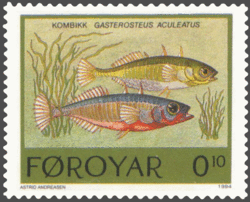Tag Archives: genus
Male Fish Won’t “Ask For Directions”
Recent research has come to the astonishing conclusion that fish, specifically the males, positively refuse to ask for directions when they are breeding.
A recent research project, by the University of St. Andrews, has found that male fish seem to become more anti-social feeders, becoming even more so when they are ready to spawn.
As a result of this, they put themselves in greater peril, by leaving the shoal behind.
The claim is being made by researchers in charge of the project that this is one of the first studies performed that has shown a differences in the sexes when it comes to how animals learn from one another.
The current belief is that this trait is only seen in male fish when they are getting ready to spawn or are spawning, and may correlate to the distinct pressures faced by the sexes when spawning.
The research was conducted by Dr. Mike Webster and Professor Kevin Laland, whose goal was to take a look at the copying and learning behaviors of ninespine stickleback.
It appears the males tend to look for food reserves on their own, so that they can properly protect their young when the time comes, and this is why they don’t feed together.
Dr Webster added: “We are all familiar with the stereotype of males refusing to ask for directions – this might apply to fish too, but only when they are preparing to breed.”
New genus created in danioninae revision
A study of the molecular phylogenetic interrelationships of south Asian cyprinid genera Danio, Devario and Microrasbora has resulted in a reclassification of the group and the creation of a new genus: Microdevario.
The study, which has been published in a recent issue of the journal Zoologica Scripta, was carried out by Fang Fang and his colleges at the Swedish Museum of Natural History.
The researchers examined the molecular phylogeny of the Danioninae using fragments of the mitochondrial cytochrome b and nuclear rhodopsin genes from 68 species, including 43 danioinine species.
The analysis revealed the species Microrasbora rubescens and the genera Chela, Laubuca, Devario, and Inlecypris to form a natural group, the Devario clade, with the species Microrasbora gatesi, Microrasbora kubotai and Microrasbora nana being in sister group position to the rest.
Zebrafish
These findings, in combination with subsequent analysis of morphological characters, have made the authors propose four taxonomic changes:
· The species Inlecypris auropurpurea is reassigned as Devario auropurpureus.
· Microrasbora gatesi, Microrasbora kubotai and Microrasbora nana are reassigned to a new genus named Microdevario. Fish of this genus are distinguished from other danioinines by a combination of skull and jaw characters.
· Reassignment of the species Celestichthys margaritatus to the genus Danio in previous studies is confirmed.
· The membership of Chela is restricted to Chela cachius. All other species previously placed in this genus are reassigned to the genus Laubuca, except Chela maassi, which is in the genus Malayochela.
For more information about the study and the suggested taxonomic changes, see the paper Fang, F, M Norén, TY Liao, M Källersjö and SO Kullander (2009) Molecular phylogenetic interrelationships of the south Asian cyprinid genera Danio, Devario and Microrasbora (Teleostei, Cyprinidae, Danioninae). Zoologica Scripta 38, pp. 237–256.
The genus Puntius gets a new species from Sri Lanka
Sri Lankan scientists have described a new species of fish from south-western Sri Lanka and placed in the genus Puntius.
Unlike its close relatives in Sri Lanka and India, the new species Puntius kelumi feature a combination of a smooth last unbranched dorsal-fin ray, a body depth that is 28.6-35.5 % of standard length (SL), maxillary barbels (about as long as the eye diameter) but no rostral barbels, 20-23 lateral-line scales on the body, and ½3/1/2½ scales in transverse line from mid-dorsum to pelvic-fin origin. One breeding males, the sides of the head and body are rough and extensively tuberculated.
Puntius kelumi is primarily found in large streams with clear water that flows down from the mountains. The bottom is typically made up by granite, pebbles and/or sand and is often littered with boulders.
The description was published by the journal Ichthyological Exploration of Freshwaters.
For more information about Puntius kelumi, see the paper: Pethiyagoda, R, A Silva, K Maduwage and M Meegaskumbura (2008) Puntius kelumi, a new species of cyprinid fish from Sri Lanka (Teleostei: Cyprinidae). Ichthyological Exploration of Freshwaters 19, pp. 201–214.
http://www.pfeil-verlag.de/04biol/pdf/ief19_3_02.pdf
A picture of the new species can be seen here
_____________________
Puntius is a genus of ray-finned fishes in the family Cyprinidae. All known members of the genus are native to Southeast Asia and India, including Sri Lanka. The name Puntius is derived from the word pungti, which is the term for small cyprinids in the Bangla (Bengali) language.
Puntius fish are commonly referred to as spotted barbs, but some species display vertical black bands instead of spots. Spotted barbs are commonly kept by aquarists and are known to be active, curious and bold. Many of them are unsuitable companions for fish with long and flowing finnage since they tend to nip such fins, a habit which causes both injury and stress in the afflicted animal.

